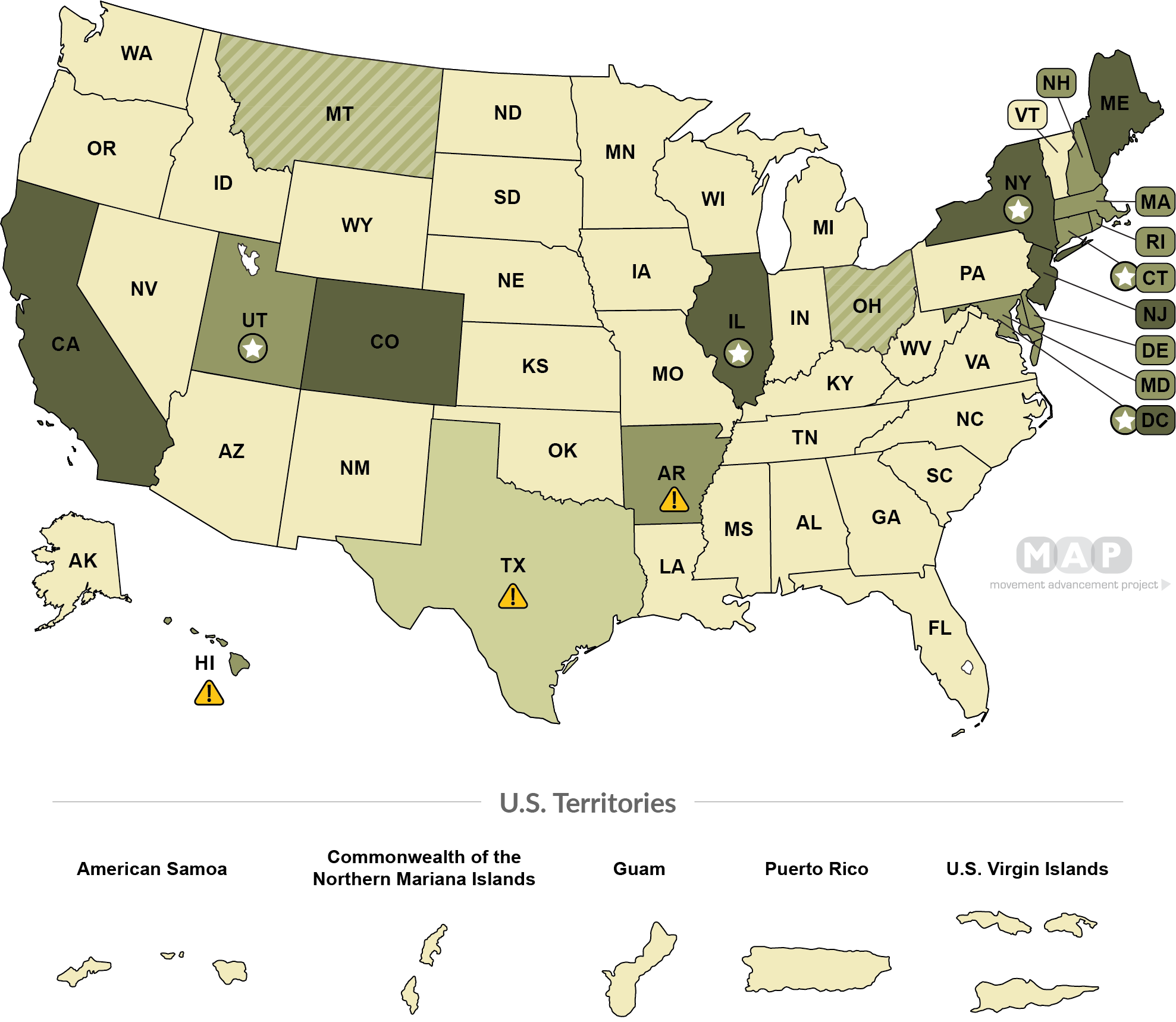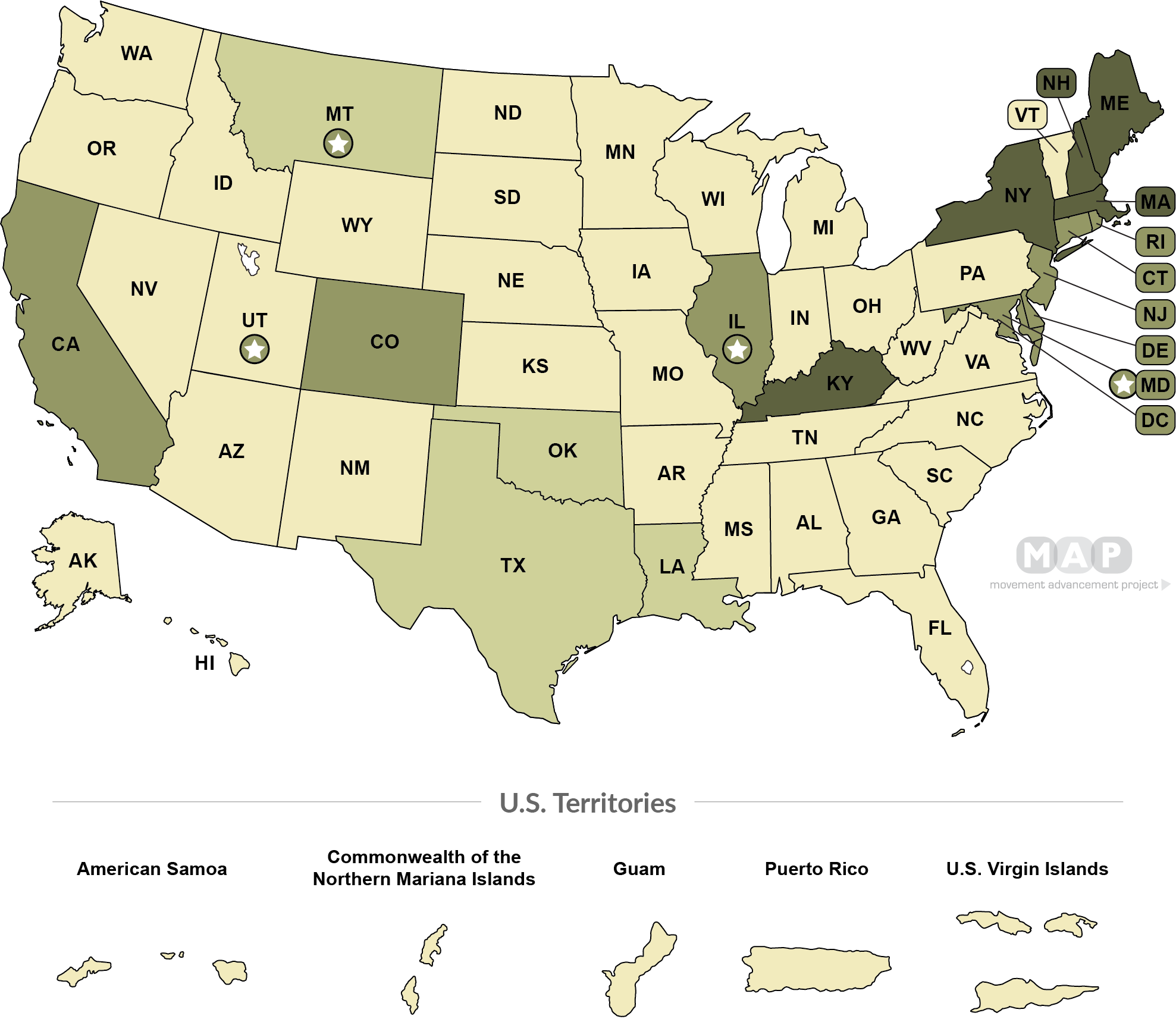Fertility-related health care is diverse and can include fertility treatment services such as medications to assist in conception, in vitro fertilization (IVF), and other health care. It may also include fertility preservation services, such as egg retrieval and storage. In the United States, however, fertility-related healthcare is often not covered by insurance. As a result, some states have passed laws that require insurers to cover fertility treatment and/or preservation care. But, even when fertility health care is covered by insurance, many states still have definitions of “infertility” or other terms that exclude single people and many LGBTQ people from otherwise covered services. As a result, LGBTQ people may have to spend thousands of dollars in out-of-pocket costs to grow their families, even when these services are covered for other people. These Equality Maps track current laws regarding state-mandated coverage of fertility treatment and fertility preservation by both private insurers and state Medicaid programs.

-
State requires private insurers to cover fertility treatment care and is explicitly inclusive of LGBTQ people
(6 states + D.C.)
-
State requires private insurers to cover fertility treatment care
(9 states)
-
State requires coverage by at least some private insurers or of at least some fertility care, but requirements differ across states (see citations for more detail)
(2 states)
-
State requires private insurers to offer coverage, but employers may still choose not to include that coverage
(1 state)
-
State does not require private insurers to cover fertility treatment care
(32 states, 5 territories)
-

State requires Medicaid to cover at least some fertility treatment care, though coverage differs across states (see citations for more detail)
(4 states + D.C.)
-

State has requirements or language that may exclude some LGBTQ people or couples
(3 states)
Please note: These maps are not intended to be legal advice or other advice related to health or insurance. Please consult with lawyers or other professionals as needed.Thank you to GLAD for their partnership in developing these maps.
Recommended citation:
Movement Advancement Project. [Year of access]. “Equality Maps: Fertility Healthcare Coverage.” www.mapresearch.org/equality-maps/healthcare/fertility_coverage. Accessed [day of access].
Percent of Adult LGBTQ Population Covered by Laws
*Note: These percentages reflect estimates of the LGBTQ adult population living in the 50 states and the District of Columbia. Estimates of the LGBTQ adult population in the five inhabited U.S. territories are not available, and so cannot be reflected here.
26 % of LGBTQ adults (18+) live in states that require private insurers to cover fertility treatment care and are explicitly inclusive of LGBTQ people
9 % of LGBTQ adults (18+) live in states that require private insurers to cover fertility treatment care
4 % of LGBTQ adults (18+) live in states that require coverage by at least some private insurers or of at least some fertility care, but requirements differ across states (see citations for more detail)
8 % of LGBTQ adults (18+) live in states that require private insurers to offer coverage, but employers may still choose to not include that coverage
53 % of LGBTQ adults (18+) live in states that do not require private insurers to cover fertility treatment care
Fertility-related health care is diverse and can include fertility treatment services such as medications to assist in conception, in vitro fertilization (IVF), and other health care. It may also include fertility preservation services, such as egg retrieval and storage. In the United States, however, fertility-related healthcare is often not covered by insurance. As a result, some states have passed laws that require insurers to cover fertility treatment and/or preservation care. But, even when fertility health care is covered by insurance, many states still have definitions of “infertility” or other terms that exclude single people and many LGBTQ people from otherwise covered services. As a result, LGBTQ people may have to spend thousands of dollars in out-of-pocket costs to grow their families, even when these services are covered for other people. These Equality Maps track current laws regarding state-mandated coverage of fertility treatment and fertility preservation by both private insurers and state Medicaid programs.

-
State requires private insurers to cover fertility preservation, including storage
(5 states)
-
State requires private insurers to cover fertility preservation, but not storage
(8 states + D.C.)
-
State requires private insurers to cover fertility preservation, but only for cancer patients
(4 states)
-
State does not require private insurers to cover fertility preservation
(33 states, 5 territories)
-

State requires Medicaid to cover at least some fertility preservation services, or for at least some (i.e., cancer) patients (see citations for more details)
(4 states)
Please note: These maps are not intended to be legal advice or other advice related to health or insurance. Please consult with lawyers or other professionals as needed.Thank you to GLAD for their partnership in developing these maps.
Recommended citation:
Movement Advancement Project. [Year of access]. “Equality Maps: Fertility Healthcare Coverage.” www.mapresearch.org/equality-maps/healthcare/fertility_coverage. Accessed [day of access].
Percent of Transgender Population Covered by Laws
*Note: These percentages reflect estimates of the transgender population (ages 18+) living in the 50 states and the District of Columbia. Estimates of transgender people in the U.S. territories are not available, and so cannot be reflected here. Population estimates are from The Williams Institute.
11 % of transgender adults (18+) live in states that require private insurers to cover fertility preservation, including storage
24 % of transgender adults (18+) live in states that require private insurers to cover fertility preservation, but not storage
10 % of transgender adults (18+) live in states that require private insurers to cover fertility preservation, but only for cancer patients
55 % of transgender adults (18+) live in states that do not require private insurers to cover fertility preservation





